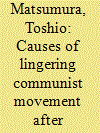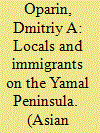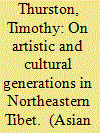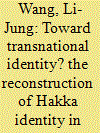| Srl | Item |
| 1 |
ID:
157957


|
|
|
|
|
| Summary/Abstract |
This article focuses on the communist movement on both sides of the border in Sarawak and West Kalimantan around 1965 when the September Thirtieth Movement (abortive coup) took place in Jakarta. The people in Sarawak were seeking independence and opposed to being integrated into the Federation of Malaysia in the first half of the 1960s. However, after the September Thirtieth Movement, the communist movement in Sarawak started losing support both domestically and internationally (especially support from Indonesia). Nevertheless, even with the persecution by Suharto’s army, the Sarawak guerrillas and the Indonesian Communist Party in West Kalimantan cooperated in their struggle for a few years after 1965. This situation was aided by the remoteness of these areas from the centers of the nation-states (Malaysia and Indonesia) and also by the cooperation between the guerrillas and the local Chinese in West Kalimantan.
|
|
|
|
|
|
|
|
|
|
|
|
|
|
|
|
| 2 |
ID:
157958


|
|
|
|
|
| Summary/Abstract |
Western Siberia and the entire Arctic region have been a beacon for migrants from the European part of Russia, from the national republics and the southern regions of Siberia in the post-war era. In contrast with the other regions of Siberia, the oil- and gas-rich North remains a magnet for migration from the entire former Soviet Union to this day. This paper presents research into the contemporary sociocultural environment of Yar-Sale, the administrative centre of the Yamal district of Yamalo-Nenets Autonomous Okrug. The research focuses on the migrational experiences of ‘new’ migrants and their relations with the native Nenets population. Special attention is paid to concepts such as ‘local’/‘immigrant’, and ‘insider’/‘outsider’. The author holds that the boundaries between these categories are flexible. An immigrant may become a local and an insider may become an outsider, with ethnicity far from always being the deciding factor.
|
|
|
|
|
|
|
|
|
|
|
|
|
|
|
|
| 3 |
ID:
157953


|
|
|
|
|
| Summary/Abstract |
Beginning in the 1980s, and continuing for over three decades since, a particular generation of Tibetans from the Northeastern Tibetan region known as Amdo, and particularly from the northern parts of China’s Qinghai province, has proven extremely productive. Why has this generation, born primarily between 1959 and 1967, been so incredibly successful? This article examines the contextual factors that may have contributed to the incredible success of this generation. This ranges from the policies and circumstances that affected their births, and the state of the cultural field at the time they reached adulthood. Personal experience narratives, autobiographies, and scholarly studies then reveal how this generation was able to access the intellectual field. Finally, I briefly discuss how the Amdo Tibetan intellectual field compares with other Tibetan and ethnic experiences in the People’s Republic of China.
|
|
|
|
|
|
|
|
|
|
|
|
|
|
|
|
| 4 |
ID:
157955


|
|
|
|
|
| Summary/Abstract |
The Rohingya of Myanmar have been experiencing a range of human rights violations including state-sponsored genocide and ethnic cleansing. Many argue that the genesis of the crisis lies in the denial of their legal status and granting citizenship would offer a solution. This article argues that apart from such legal dynamics, significant theoretical aspects of this crisis require analysis. From a theoretical perspective, the Rohingya’s identity as a minority is important as it leads to their persecution. This article demonstrates that their minority identity has been (re)constructed over time. Four factors such as (i) development of Burmese nationalism; (ii) politicisation of identity for Burmese majority; (iii) taking away of the citizenship of Rohingya; and (iv) ethnic divisions in Myanmar society have played significant roles in (re)constructing their identity as a minority. They give rise to a type of citizenship in Myanmar, which fails to include the religious minority within its ambit.
|
|
|
|
|
|
|
|
|
|
|
|
|
|
|
|
| 5 |
ID:
157956


|
|
|
|
|
| Summary/Abstract |
The Hakka people (Hakkas) are a global cultural ethnic group. This article explored the experiences of the Hakkas in Thailand. One major ethnic minority in Thailand is the Chinese people (14 percent of the total population) who engage in businesses and commerce throughout the country. Fifty-six percent of the Chinese are Chaozhounese, and 16 percent are Hakkas. This article argued that the Thai-Hakka identity is a transnational construction mobilized by multiple agencies at the local, national, and global levels. This identity is a result of the negotiation from the common motherland (China) in the past, the new modern Hakka discourse and the multicultural policy (Taiwan), and the complex ethnic experiences and interactions in everyday life (Thailand). Compared to the traditional diaspora viewpoint (pluri-locally distributed, with a strong identity to the motherland), the Thai-Hakka identity has gravitated towards a new path of transnational identity (pluri-locally distributed, without a clear centre–periphery relation).
|
|
|
|
|
|
|
|
|
|
|
|
|
|
|
|
| 6 |
ID:
157954


|
|
|
|
|
| Summary/Abstract |
Studies of Southeast Asian Chinese are voluminous; yet, those about the Chinese in Vietnam are comparatively few. This article provides an updated account of the Chinese Vietnamese with focuses on the Chinese associations in the South of Vietnam and the shifting Chinese identity. Many have discussed the Chinese Vietnamese who fled Vietnam in the 1970s and 1980s, however, little is known about the plights of the Chinese inside Vietnam during those decades. This article elaborates on their situations in the post-unification decade in Ho Chi Minh City and the subsequent changes after the doi moi reforms in the 1990s. It will show how a liberalized economy and accommodative ethnic policies have resulted in a more proactive relationship between the Chinese minority and the Vietnamese society, which consequentially led to changes in the relationship between the Chinese in Vietnam and China.
|
|
|
|
|
|
|
|
|
|
|
|
|
|
|
|